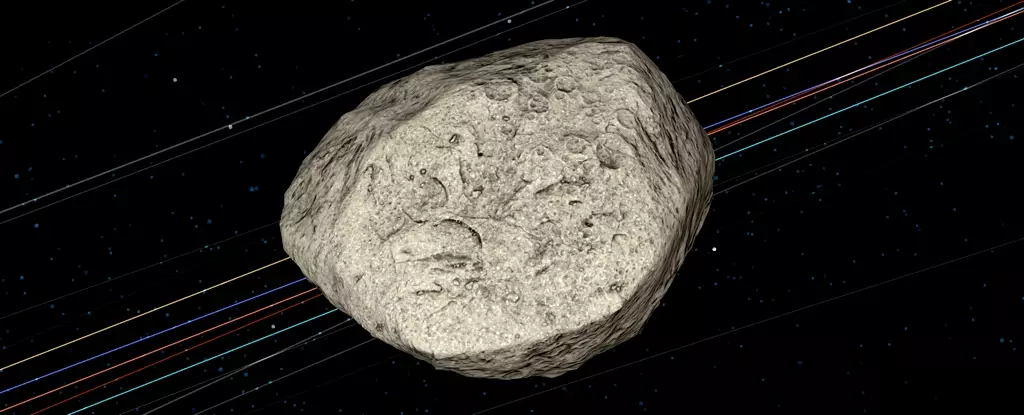Asteroid 99942 Apophis, named after the ancient Egyptian deity symbolizing chaos, has captured the attention of astronomers since its discovery in 2004. Initially, its trajectory caused considerable alarm, with predictions of a potential collision with Earth in April 2029. Fortunately, extensive calculations provided reassurance: Apophis will pass within approximately 32,000 kilometers (20,000 miles) of our planet but will pose no threat for at least the next century. Yet, while Earth’s inhabitants breathe a sigh of relief, scientists have turned their focus to the intriguing effects this close encounter might have on the asteroid itself.
The Peculiar Nature of Near-Earth Asteroids
Ronald Ballouz, a planetary scientist at the Johns Hopkins University Applied Physics Laboratory, leads a team investigating the peculiar features of near-Earth asteroids like Apophis. What makes these celestial bodies particularly fascinating is their surprisingly youthful surfaces, which seem to defy expectations given their prolonged existence in the Solar System—around 4.5 billion years. While asteroids normally endure constant bombardment from solar winds and micrometeoroids, altering their surfaces over time, near-Earth asteroids display significant differences. They tend to have loose, rubbly surfaces and appear less weathered compared to their more remote counterparts.
This discrepancy perplexes scientists, as one would expect all asteroids to exhibit a degree of weathering from space conditions. Ballouz’s investigative approach centers on the gravitational interactions during close passes, hypothesizing that these encounters could significantly rejuvenate an asteroid’s surface.
In exploring the mechanics of 99942 Apophis’s flyby, Ballouz and his colleagues utilized modeling techniques to predict the changes that gravity will impose during its approach. While detailed studies have not fully revealed the asteroid’s shape, early observations suggest it may resemble a bi-lobed structure—akin to the potato-shaped asteroid 25143 Itokawa. By simulating Apophis’s flyby while adjusting the model’s characteristics, they aimed to discern how Earth’s gravitational pull might influence Apophis’s properties.
The team identified two primary effects resulting from the gravitational interaction. Initially, as Apophis draws nearer, short-term seismic activities are expected. This would be the result of rapid shifts as the asteroid experiences gravitational forces, potentially generating detectable seismic events that could alter its surface. These events may mimic an earthquake’s effects, creating measurable shifts in the surface structures of the asteroid.
Long-Term Consequences: A New Rotation, A Renewed Surface
The second, more enduring transformation is linked to changes in the asteroid’s rotational state. The interaction with Earth’s gravitational field during the flyby could alter its spin, thereby impacting its trajectory further into the future. Over thousands of years, as Apophis continues to orbit the Sun, its altered spin could result in surface material movement. This phenomenon implies that the asteroid will not only come away from its encounter with Earth physically disturbed but may also “refresh” its surface features over time.
Prior research suggests that flybys occurring within a specific distance—about 102,000 kilometers—can significantly influence an asteroid’s spin state. The forthcoming close approach of Apophis is expected to be well within that threshold, confirming the likelihood of observable surface alterations. While results from these phenomena may be challenging to directly quantify, alterations in the asteroid’s spin, and the detection of surface changes, remain viable areas for scientific study.
Excitement is building within the scientific community as the date of Apophis’s close flyby approaches. This event will not only enable astronomers to observe and study the asteroid up close, but it will also allow for a unique opportunity to gather data on its surface changes in real time. With the potential for visible observation, amateur and professional astronomers alike will have the chance to witness a celestial spectacle while contributing to our understanding of asteroid dynamics.
While 99942 Apophis has proven to be a temporary concern for Earth, it stands as a remarkable subject for scientific research. The gravitational pull of our planet serves as a natural experiment, enhancing our knowledge of not only Apophis but also the broader category of near-Earth asteroids. As we prepare to greet this celestial visitor, we hold out hope that its journey concludes with valuable insights rather than chaos.


Leave a Reply